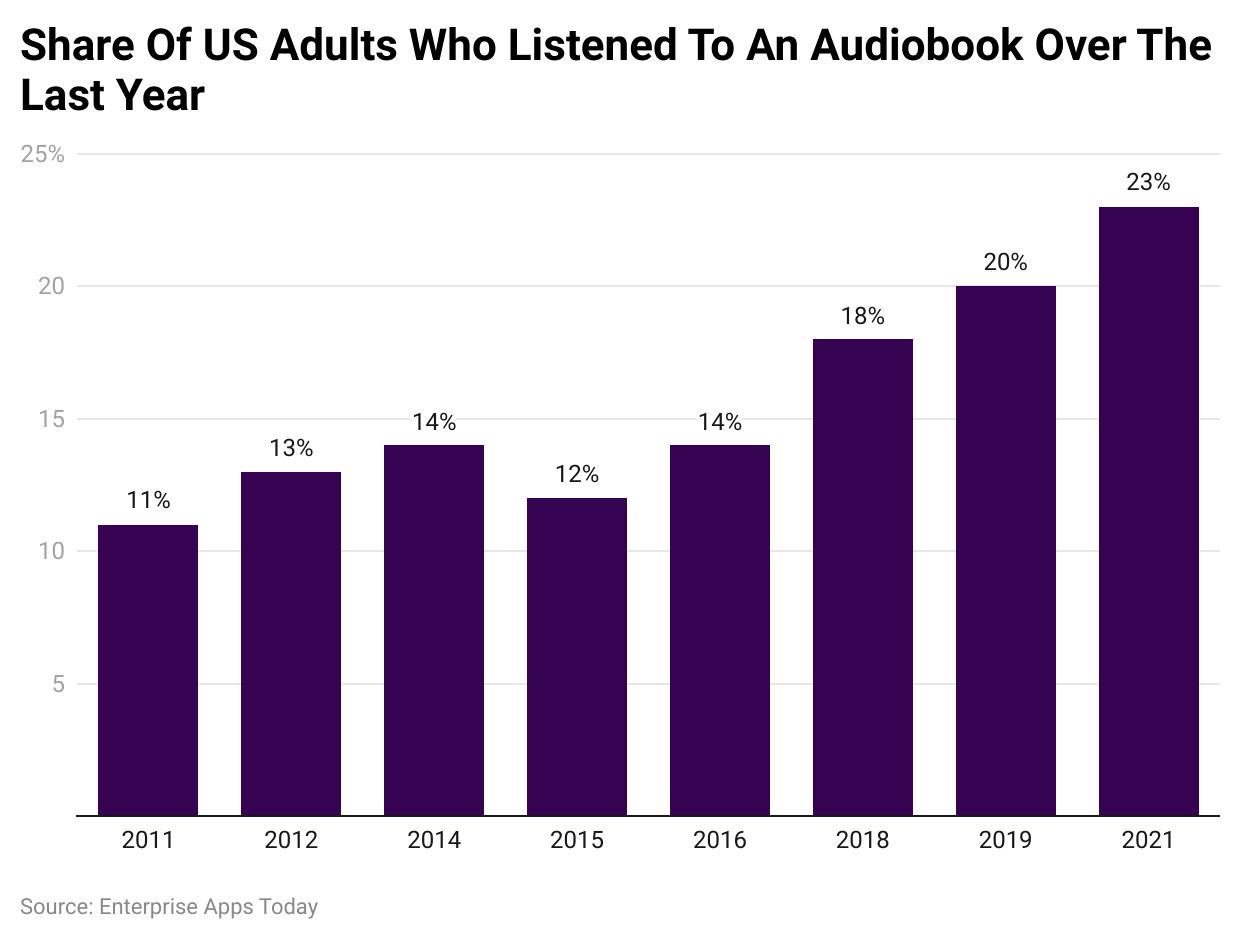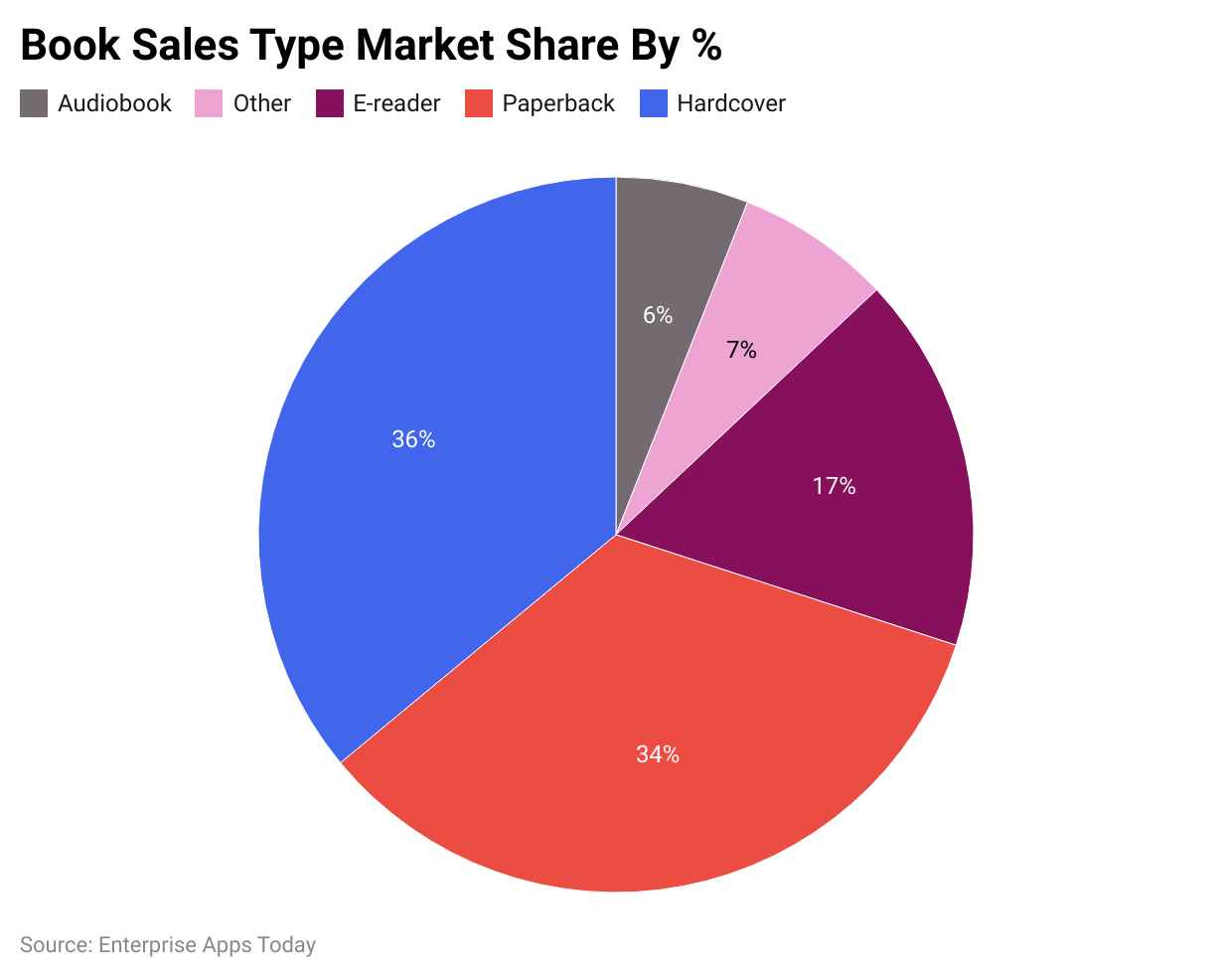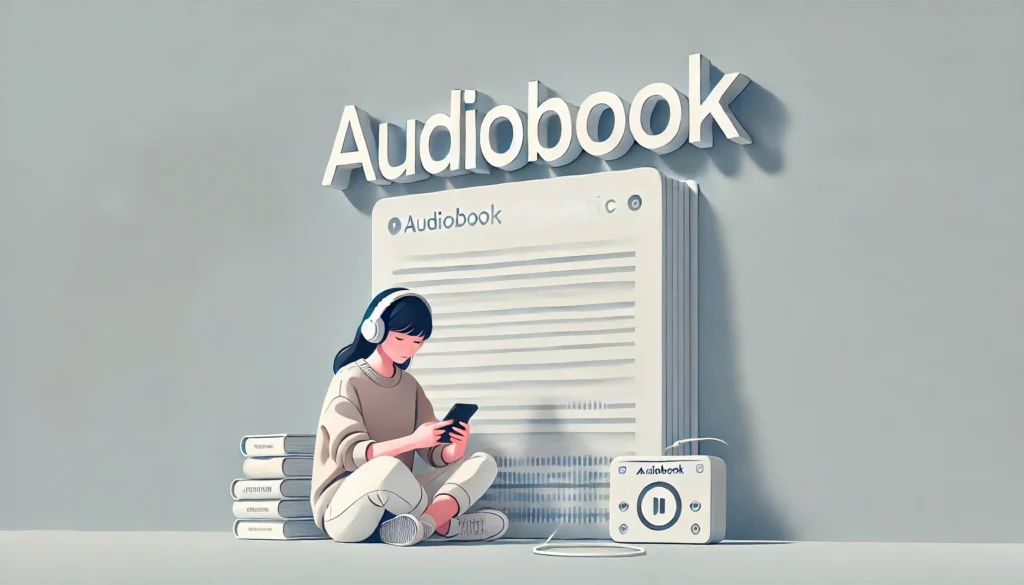Introduction
Contents
- Introduction
- Editor’s Choice
- Audiobook Listening Habits
- Audiobook Publishing Statistics
- By Preferred audiobook Genres
- By Listeners Experience
- Audiobook Sales Statistics
- Fascinating Audiobook Statistics
- Audiobooks in Audible
- Current Developments In Audiobook
- How Many People Listen To Audiobooks?
- How Much Does It Cost to Publish an Audiobook?
- Conclusion
Audiobook Statistics: Audiobooks have rapidly transformed the book publishing industry, becoming a mainstream format that is reshaping the way consumers engage with content. In recent years, audiobooks have surpassed eBooks in popularity, driven by the convenience and accessibility they offer through electronic devices. According to Edison Research, as of 2024, 52% of U.S. adults have listened to an audiobook, equating to approximately 137 million people.
The growing adoption is further reflected in the user penetration rate, which is expected to reach 18.7% in 2024 and increase to 21.7% by 2029. On average, audiobook listeners consumed 6.8 titles in the past year, up from 6.3 in 2023, with children’s audiobook listening also strong, as 53% of parents report their kids engage with audiobooks. Globally, the U.S. leads the market, projected to generate USD 3.4 billion in revenue by 2024, with an average revenue per user (ARPU) of USD 5.46.
This rise in demand highlights a broader trend toward immersive and on-the-go storytelling experiences, underscoring audiobooks’ growing influence in the media landscape.
Editor’s Choice
- In 2020, the global audiobook market grew significantly, reaching sales of USD 1.2 billion, a 17% rise from the previous year.
- In 2022, 53% of American adults listened to audiobooks, an increase from 35% in 2023. This means approximately 140 million.
- Americans have tried listening to audiobooks.
- Fiction is the top-selling audiobook category, making up 64% of revenue, with popular genres being General Fiction (21%), Science Fiction/Fantasy (14%), and Romance (11%).
- Audiobooks are popular with people aged 18-44, representing 57% of listeners.
- Mystery and suspense make up 42% of audiobook sales in the United States.
- Audiobooks for children are also growing, with 53% of parents reporting their kids listen to audiobooks, and 77% saying audiobooks offer a break from screen time.
- In 2020, the United States held 52.8% of the global audiobook market share.
- Subscription services like Audible are on the rise, with 63% of listeners subscribing to at least one service.
- Many audiobook users borrow audiobooks from digital library apps, with 46% doing so in 2022.
- Piracy is a concern, as 47% of listeners got audiobooks for free through YouTube or file-sharing websites.
- Listeners prefer audiobooks lasting 10-20 hours, and the quality of the narrator is a key factor for choosing an audiobook.
- Non-English language content is increasing, making up 37% of new content in the U.S., though it only accounts for 4% of total market value.
- 67% of listeners say they “read” more using audiobooks.
- The average listener consumed 6.8 audiobooks in 2022, up from 6.3 in 2023.
- In 2022, audiobook listening returned to pre-pandemic levels, with 6.3 audiobooks listened to on average.
- Subscription services made up 41% of all audiobooks sold in 2020.
- The U.S. audiobook market reached an estimated USD 28.10 billion in 2022.
- In 2020, the Australian audiobook market was valued at AUD 58 million, and the Canadian market at CAD 17.05 million, with a 26.1% CAGR.
- Most people listen to audiobooks on smartphones (56%), followed by computers (26%) and tablets (14%).
- Health & Fitness and History/Biography/Memoir audiobooks grew by 20% and 22%, respectively, in 2022.
- Almost 60% of listeners stopped listening to an audiobook because they didn’t like the narrator.
Audiobook Listening Habits
- Over 45% of Americans had listened to an audiobook at least once in their life as of 2022.
- The number of US adults listening to audiobooks has more than doubled in the past 10 years.
- Over 23% of Americans listened to at least one audiobook in 2021, which is a 15% increase from 2020.
- Younger people are more likely to consume audiobooks, with 57% of Americans under 50 listening to audiobooks in 2021.
- Women listen to audiobooks more than men, with women being 13.6% more likely to use audiobooks.
- Over 26% of African Americans listened to audiobooks in the past year.
 (Reference: wordsrated.com)
(Reference: wordsrated.com)
Audiobook Publishing Statistics
- Nearly 9,300 words of the text equal one hour of Audiobook length.
- The minimum audiobook is almost 10 hours long and contains 100,000 words.
- On average, narrators charge almost $200 per hour, meaning the narrator’s expense amounts to $2000 for recording a book.
- It is essential to rent a studio where the recording will take place.
- Production of an audiobook will take between $4000 and $8000.
- Many industries offer a complete service for a fixed price, nearly 6,000.
- In the year 2021, about 74,000 audiobooks were introduced in the United States, a 4.23% increase from the previous year.
- Audiobooks are the fastest-growing book format in the United States per Production volume, addition, revenue, and sales growth.
- Over the last five years, the production and publishing of new audiobooks increased.
By Preferred audiobook Genres
- The audiobook format is the fastest-growing in U.S. publishing.
- If growth continues, audiobooks may become more popular than e-books and traditional print books.
- 67% of listeners say they “read” more using audiobooks than with traditional books.

- Audiobooks fit well into daily routines, making it easier for busy people to enjoy books.
- Audiobooks are now as popular as reading physical books.
- When choosing a new book, one-third of respondents prefer audiobooks, one-third prefer reading, and one-third decide based on the book.
- Fiction is more popular than non-fiction in audiobooks.
- Mystery and Thriller are the top genres, enjoyed by 55% of listeners.
- Science Fiction and Fantasy are also popular, with 48% of listeners enjoying these genres.
- Business and Personal Finance are the least popular, with only 21% of listeners interested in this genre.
By Listeners Experience
- Narrators have a big impact on the audiobook experience.
- 64% of listeners think a high-quality narrator is key to enjoying an audiobook.
- 59% of people stopped listening to an audiobook because they didn’t like the narrator.
- 30% of listeners feel that audiobooks are more immersive than reading a book.
- AI is starting to be used for audiobook narration on platforms like Apple Books and Google Play Books.
- 55% of listeners haven’t listened to an audiobook with AI narration yet.
- 21% of listeners are unsure if they have experienced AI narration.
- Only 24% of listeners know they have listened to an AI-narrated audiobook.
- Many listeners are skeptical about AI narration, with 53% doubting the quality it can offer.
- 47% of listeners are open to AI-narrated audiobooks, but many still prefer human narrators.
- 33% of listeners would consider AI narration but would rather have a human narrator.
- 20% of listeners wouldn’t consider AI-narrated books at all.
- Only 13% are very open to AI narration and believe it could provide a similar experience to human narration.
Audiobook Sales Statistics
- In 2022, audiobook sales in the United States generated over USD 1.81 billion.
- Audiobook sales in the US grew by 3.43% from 2021, which was the slowest year for this format.
- Audiobooks now make up 9% of all book sales in the US as of 2022.
- Over the past 5 years, audiobook sales revenue in the US has increased by more than 50%.

- Fiction audiobooks account for more than 65% of all audiobook sales, while nonfiction is growing by 27.5% each year.
- In 2019, audiobook revenue surpassed ebook revenue for the first time, and the gap continues to grow.
- In 2022, over 74,000 audiobooks were published in the US.
- Outside the US, China is the largest audiobook market, followed by Europe.
- In 2020, over 569 million people in China listened to an audiobook, more than double the number in 2016.
- The European audiobook market is valued at over USD 850 million and is expected to grow by 18.6% each year until 2025.
- Germany holds more than 32% of the European audiobook market.
- Nordic countries are becoming fast-growing markets for audiobooks.
US Audiobook Sales
- In 2020, Audiobook listeners bought 20% off more books than in the previous year.
- In 2020, audiobooks were estimated to be about 1/6th of all the books sold.
- Science fiction and mystery are prevalent genres of audiobooks, whereas romance shows the most significant growth and growing 75% in sales over the previous year.
- A survey says nonfiction genres are expected to show a high growth rate in 7 years, which grows by 27.5% yearly.
| Year | Audiobook revenue by year ($ billion) | Change |
| 2022 | 1.81 | 3.43% |
| 2,021 | 1.75 | 12.90% |
| 2,020 | 1.55 | 13.14% |
| 2,019 | 1.37 | 16.10% |
| 2018 | 1.18 | 28.26% |
| 2,017 | 0.92 | 28.85% |
| 2016 | 0.71 | 25.70% |
| 2015 | 0.57 |
(Source: wordsrated.com)
- Fiction audiobooks are a big category, accounting for about 65% of all audiobook sales.
- In March 2022, 9% of all book sales in the United States will be attributed to audiobook format.
- The United States audiobook market is predicted to grow by 20% to -25 % per year in the next seven years.
- In 2021, the United States had the world’s biggest audiobook market, with an estimated $1.87 billion.
- In the last five years, audiobook revenue in the United States increased by 54%, making it the fastest-growing sector.
- In 2021, audiobook revenue was $1.81 billion, an increase of 3.43% from the previous year.
Fascinating Audiobook Statistics
- As per GrandviewResearch, the audiobook organization took in yearly revenue of $4.219 billion in 2021.
- The audiobook segment of the book industry is predicted to grow at a yearly rate of 26.4% from 2022 to 2030.
- As per The Writing Cooperative, the popular ways to read books are hardened with a 36% market share. Digital forms of reading win 23% of the market.
- According to Statista, in 2021, the standard number of audiobooks published yearly has increased by about 74,000 titles over the last ten years.
- As per IbisShare, Audible has almost 63.4% market share in the audiobook sector. Other competitors in the audiobook market are Apple Books, Google Play Books, etc.
- Kobo’s royalty fee ranges from 55% to 68%. Books above $2.99 have a 55% fee.
- Apple Books has a 70% royalty fee for all kinds of books.
- Audible charges a 75% royalty fee on audiobook sales, reducing it to about 60% if the author decides to sell on the correct platform.
 (Reference: booklinker.com)
(Reference: booklinker.com)
- A 2020 survey showed that the minimum number of audiobooks in United States customers listen to 8.1 books per year.
- According to Publishers Weekly, about 50% of people listen to audiobooks at home, 30% listen while driving or in the car, and 15% listen while doing other things. The survey also stated that 70% of audiobook listeners use them while multitasking.
- According to KOBO, audiobooks average 28MB or 10 hours. This is also compared to the Kindle e-book size of 300 pages and 75,000 words of text.
- Audiobook professional narrators start at $150 per hour, and some famous narrators charge $450 annually.
- The first ever Audiobook was released in 1932 on vinyl records. This was published so that blind people could have access to books.
Audiobooks in Audible
- Audible is the biggest name in the audiobook industry and leads in generating revenue.
- Over the last five years, Audible has taken a strong lead over its competitors in the audiobook market.
- Audible made USD 1.01 billion from audiobook sales and subscriptions.
- It holds 63.4% of the US audiobook market.
- Five years ago, Audible’s market share was 41%.
- Since 2018, Audible’s market share has grown by 57%.
- Audible only publishes 13.5% of the total audiobooks each year.
- Despite this, it earns twice as much per audiobook sold compared to the rest of the industry.
Current Developments In Audiobook
- In December 2021, Amazon introduced Alexa Together, a new sector that permits users to stay connected with their aging loved ones through voice techniques.
- In May 2021, Amazon announced that it would obtain MGM Studios, one of the old and different Hollywood studios, for USD 8.45 billion.
- In February 2022, Amazon introduced Kindle Vella, a new service sector that allows authors to publish serial stories in small-size episodes.
- In May 2023, Amazon also introduced an audio discovery engine named “Snackable AI” to reinforce its podcasting initiatives.
How Many People Listen To Audiobooks?
- Almost 45% of adults in America have listened to audiobooks by 2021.
- As per the study, the US population of 18 years and above is nearly 116.25 million.
- The UK data survey says that 44.3% of English or American adults listen to Audiobooks.
- As per the adult count in 2021, 24.77 million listen to Audiobooks.
- In China, about 42,456 respondents, or 32.7%, will listen to audiobooks in 2022.
How Much Does It Cost to Publish an Audiobook?
- Producing an audiobook involves several steps, including equipment, software, a studio, and a narrator.
- The cost of producing an audiobook can vary depending on these factors.
- Audiobook narrators typically charge about USD 200 per finished hour of audio.
- An average audiobook is around 10 hours long, which contains close to 100,000 words.
- A book with 9,300 words generally equals one hour of audio.
- The total cost for the narrator is approximately USD 2,000 for a 10-hour audiobook.
- Renting a recording studio or buying equipment for home recording adds more costs.
- The total cost to produce an audiobook usually ranges from USD 4,000 to USD 8,000.
- Some companies offer full audiobook production services at a fixed price, often around USD 6,000.
Conclusion
The audio quality of the Audiobooks is the most essential factor that keeps the listeners engaged, and many of us would not think twice. More people have discovered that they can listen to audiobooks on different devices, increasing their popularity. As the audio clip routine expands, it can be expected that the Audiobook industry will grow, and it might also need more publishers and individual authors to turn to audio to have their stories to tell.
At last, until AI- narrations can breathe life into stories in the way that human beings can or will continue to slant robot storytellers with corrections.


